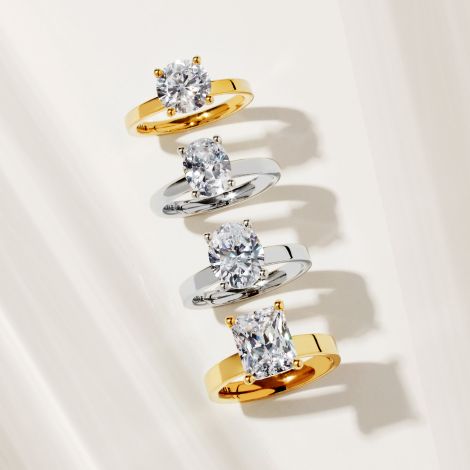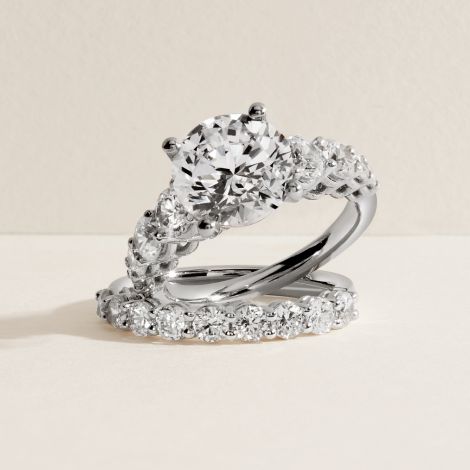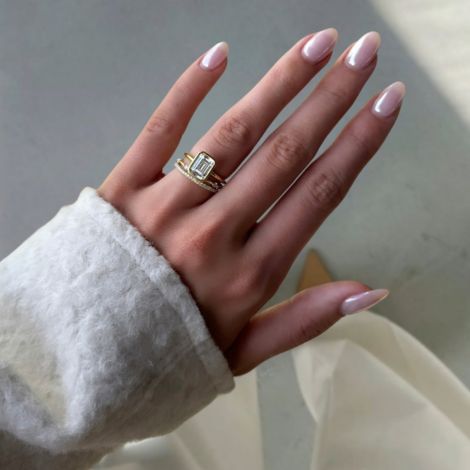When shopping for an engagement ring you’ll wear every day, selecting the design is one of the most important decisions. The right metal sets the tone, stylistically, symbolically, and practically. From the brightness of platinum to the warmth of rose gold, each option brings its own personality and performance to the ring you’ll cherish for a lifetime.
At Sylvie, we guide you through every step with intention and clarity. Whether you’re designing a custom piece or choosing from our signature collections, this guide will help you understand how to pick the best metal for an engagement ring that fits your style, budget, and lifestyle.

(from top to bottom) Round Cut Flat Edge Solitaire Engagement Ring – Harlow, Oval Cut Wide Band Solitaire Engagement Ring – Demitra, Oval Cut Flat Edge Solitaire Engagement Ring – Ember, and Radiant Cut Flat Edge Solitaire Engagement Ring – Vesta
Why Engagement Ring Metal Matters
The metal for an engagement ring isn’t just about appearance; it influences durability, maintenance, comfort, and price. It frames your diamond, supports your setting, and defines how your ring will age over time.
How Metal Affects Style, Durability & Budget
Some metals are prized for their strength, others for their color. While platinum engagement rings resist wear, 14k or 18k gold engagement ring settings offer value and flexibility. Rose gold and yellow gold add warmth and uniqueness, while white gold enhances brightness. Each metal carries different weight, feel, and long-term resilience. Understanding these distinctions will help you balance priorities like longevity, aesthetic, and cost.
Best Metal for a Diamond Ring
Choosing the best metal for a diamond ring also depends on how you want your stone to appear. White metals like platinum or white gold enhance a diamond’s brilliance and can make near-colorless stones look even brighter. Yellow or rose gold provides contrast, making the diamond pop while adding warmth and individuality.
Gold – A Classic Engagement Ring Metal
Gold is a timeless choice in bridal jewelry. Its softness allows for delicate settings, and it’s available in a range of alloys and hues to match any aesthetic.
14k vs 18k Gold Metal
When it comes to gold, purity matters, but so does practicality. 14k gold is often slightly sturdier than 18k gold due to its blend. It’s ideal for active lifestyles and long-term wear. 18k gold offers a richer tone but is softer and slightly more prone to scratching.
Best Gold Carat Metal for Engagement Rings
For most couples, 14k gold is the best gold carat metal for engagement rings, striking a balance between strength and beauty. It’s less prone to everyday damage and more accessible in price without compromising visual appeal.
White, Yellow & Rose Gold Metals
Gold offers three distinct looks for your engagement ring. Each finish changes the mood, maintenance, and how your diamond reads on the hand.
- White Gold: A white gold engagement ring features a bright, cool tone that highlights diamond precision and facet contrast. Our white gold is finished with rhodium for a crisp sheen and may be refreshed over time to maintain that mirrored look. It’s a smart choice if you love a modern aesthetic, clean lines, and versatile styling with platinum-like color at a more approachable price point.
- Yellow Gold: A yellow gold engagement ring delivers rich warmth and easy everyday wear. As one of the most popular metal color choices for engagement rings, the hue adds dimension to the setting and can make near-colorless diamonds appear even more luminous by contrast. Yellow gold pairs beautifully with solitaire engagement rings and mixed-metal stacks, and it requires minimal maintenance beyond routine cleaning and mindful wear.
- Rose Gold: A rose gold engagement ring blends gold with copper alloy to achieve a soft blush tone that complements a range of skin tones. The color brings a romantic, contemporary feel and adds definition to halo engagement rings and our modern vintage engagement rings. Rose gold is durable for daily wear; its color is inherent to the metal, so no plating touch-ups are needed.

(from left to right) Shell Auranova Sirena Half Bezel Solitaire Engagement Ring – Aureline and Auravie Shell Shapes Diamond Ring – RS1008
Platinum: The Premium Engagement Ring Metal
Platinum is a luxurious choice for those looking for durability and understated brilliance. Naturally white and hypoallergenic, platinum is one of the strongest precious metals used in fine jewelry.
Why Platinum Is a Top Engagement Ring Metal
If you want a ring that feels sturdy on your hand, cool in tone, and built for daily wear, platinum is an exceptional option. Its density ensures security for diamonds and its resistance to wear makes it ideal for intricate settings. It’s also naturally hypoallergenic, perfect for sensitive skin.
Platinum vs Gold – Which Metal Wins?
When comparing white gold vs platinum for engagement rings, it comes down to lifestyle. Platinum is denser and more durable, though heavier and more expensive. Gold, especially in 14k form, offers more variety and a lighter feel on the hand. Both are excellent choices for longevity and luxury.
Caring for Platinum Metal
Platinum requires less maintenance than white gold, as it doesn’t need replating. It develops a soft patina over time that many find beautiful. Occasional polishing will restore its original sheen.
Does Platinum Metal Scratch?
Yes, platinum metal can scratch, but instead of losing metal, it displaces it. This keeps your ring’s weight intact, unlike gold which wears down over time. The patina that develops gives the ring a soft glow and can be polished out if desired.
Silver: Affordable but Less Durable
Silver is sometimes considered as an entry-level metal, but for engagement rings, it has limitations.
Should You Choose Silver as Your Ring Metal?
While sterling silver is attractive and affordable, it lacks the strength needed for long-term engagement ring wear. It’s prone to tarnish and can bend more easily under pressure, making it less than ideal for securing diamonds. However, 14k or 18k white gold looks almost identical and creates the same jewelry aesthetic as silver while maintaining the durability that is needed for an engagement ring.
Silver vs Platinum – Metal Comparison
Though they appear similar in tone, silver and platinum perform very differently. Platinum engagement rings retain their color and strength over time, while silver may require regular cleaning and be more vulnerable to everyday wear.

(from top to bottom) Round Cut Thick Diamond Band Engagement Ring – Collins and Stackable Wedding Band – B1P11
Alternative Metals for Engagement Rings
Alternative metals are gaining traction among couples looking for modern style, affordability, or hypoallergenic options. These metals can offer durability and visual appeal, but they differ from traditional precious metals in important ways, especially in terms of maintenance, resizing, and suitability for diamond settings. Here’s what to know before selecting one for your engagement ring.
Palladium Metal for Hypoallergenic Diamond Rings
A cousin of platinum, palladium is naturally white, lightweight, and hypoallergenic. It offers a similar luster and resistance to tarnish but at a slightly lower price point. While it’s less common today due to sourcing challenges, palladium remains a refined option for those who want a platinum look with a lighter feel.
Titanium Metal for Lightweight Engagement Bands
Titanium is exceptionally strong yet remarkably light, making it ideal for active lifestyles. Its sleek, gray tone creates a modern aesthetic, though it’s not typically used to hold diamonds. Titanium is best suited for simple band styles and is hypoallergenic, but it can’t be resized.
Cobalt Metal for Scratch-Resistant Engagement Rings
Cobalt offers a bright, platinum-like finish with outstanding durability. It’s scratch-resistant, comfortable, and lower maintenance than softer metals. While not a precious metal, it’s a great choice for couples prioritizing everyday wear and toughness. Like titanium, it’s not easily resized.
Tungsten Carbide Metal for Modern Ring Styles
Favored for its industrial strength and heavy feel, tungsten carbide is highly resistant to scratches but can be brittle. It’s ideal for minimalist or men’s wedding bands, but not recommended for traditional diamond engagement ring settings due to its inflexibility.
Tantalum Engagement Rings with a Contemporary Look
Tantalum is a dark, slightly matte metal that’s both rare and durable. It’s naturally hypoallergenic and comfortable for long wear, offering a unique alternative for those who want a softer aesthetic without compromising strength.
Stainless Steel Engagement Rings for Everyday Wear
Affordable and tarnish-resistant, stainless steel provides a clean, modern look. It’s durable for casual use but lacks the refinement and customizability of traditional engagement ring metals.
Best Metal for Everyday Wear
If you plan to wear your engagement ring daily, durability becomes just as important as design. The best metal for engagement ring longevity will resist scratches, hold its color, and stand up to real life, from busy weekdays to once-in-a-lifetime moments.
Which Metal Resists Scratching and Tarnishing Best?
When it comes to resisting scratches, platinum and 14k gold are top performers. Platinum doesn’t wear down, it displaces rather than loses metal, preserving its shape even when scuffed. 14k gold offers the best balance for daily wear: it’s strong enough to withstand active lifestyles while still allowing for elegant, detailed design work. Each of these metals provides lasting beauty, making them strong contenders for everyday engagement rings.
What Is the Best Metal That Won’t Tarnish or Discolor?
Platinum leads the way in tarnish resistance, it’s naturally white and doesn’t require rhodium plating, so its color never fades. 18k and 14k gold, especially in rose and yellow gold, also retain their hue beautifully over time with minimal care.
These metals don’t oxidize like silver, and when properly maintained, they remain luminous year after year. White gold may require occasional replating, but for those drawn to cooler tones, it’s worth the simple upkeep. If maintaining color and luster over decades is your priority, investing in a high-quality metal will ensure your ring looks as radiant as the day you said yes.

(from top to bottom) Emerald Cut Bezel Set Engagement Ring – Cliodhna, Classic Spaced Diamond Wedding Ring – Eniko, and Classic Wedding Band – Adorlee
How to Choose the Best Metal for Your Engagement Ring
Choosing the right metal is about more than aesthetics, it’s about comfort, longevity, and how you want your ring to feel for years to come. Whether you’re planning on designing a unique custom engagement ring or selecting a Sylvie design with your chosen authorized retailer, these key considerations will help guide your decision.
Consider Skin Tone and Metal Color
Your skin tone can influence how a metal looks on your hand. Platinum and white gold flatter cooler undertones with their silvery brightness. Yellow gold and rose gold enhance warmer complexions with their soft glow. If your tone is neutral, you can confidently wear any shade, consider what complements your personal style.
Think About Lifestyle and Daily Wear
Durability matters. If you’re looking for engagement rings for an active woman, metals like 14k gold or platinum are resilient enough for daily wear. Softer metals like silver may show wear more quickly and require extra care. Your ring should support your routine, not the other way around.
Budget Considerations: Precious Metals vs Affordable Alternatives
For the best combination of quality and value, 14k gold is a smart choice. It is the least expensive of the precious metals, but resilient for engagement ring designs. Platinum offers prestige and longevity but comes at a higher cost.
What’s the Best Metal for Vintage-Style Engagement Rings?
Vintage-inspired rings shine in yellow or rose gold, which enhance intricate details like filigree, beading, and hand engraving. These tones add warmth and nostalgic charm, especially in heirloom-style or antique settings.
Final Thoughts: What is the Best Engagement Ring Metal?
The best metal for engagement ring designs ultimately depends on your lifestyle, style preferences, and what you want your ring to express. Whether you’re drawn to the resilience of platinum, the romantic glow of rose gold, or the everyday versatility of 14k white gold, each metal offers something unique, and meaningful.
At Sylvie, we craft each engagement ring in 14k or 18k gold (white,
yellow, or rose) and platinum, using only natural diamonds and elevated design details that feel personal and lasting. Every piece is made to celebrate your story, refined in finish, yet wearable every day.
If you’re unsure where to begin, our authorized Sylvie retailers are here to help. From explaining how metals age to guiding you through comfort, care, customization, and the 4Cs of diamonds they’ll make sure your final choice feels as good as it looks. With expert support and intentional design, your engagement ring will be a true reflection of your future, crafted to last, and made to matter.
FAQs: Best Metals for Engagement Rings
Choosing the best metal for an engagement ring often brings up specific questions. From durability to comfort, here’s what to know when comparing precious and alternative metals.
Silver, Gold, or Platinum – Which Metal Is Best?
Gold and platinum are the most popular and time-tested options for engagement rings. Silver is less durable and prone to tarnish, making it better for occasional wear. For long-term beauty and performance, 14k gold or platinum are your best choices.
What’s the Best Metal for a Diamond Ring?
To enhance a diamond’s brilliance, white gold and platinum are top picks. Both metals offer a clean backdrop that amplifies sparkle. Yellow and rose gold add contrast and warmth, creating a vintage or romantic aesthetic
depending on your diamond’s tone.
Is Platinum Better Than Gold?
Platinum is denser, hypoallergenic, and requires less maintenance than white gold, which needs periodic rhodium plating. However, gold offers more color options and can be more budget-friendly. The best choice depends on lifestyle, skin sensitivity, and tone preference.
Most Scratch-Resistant Ring Metal?
Tungsten carbide leads in scratch resistance but can crack under pressure. Platinum is a strong daily-wear option, it scratches but maintains its volume. 14k gold is also a durable and versatile choice for long-term wear.
Can You Resize Alternative Metal Rings?
Most alternative metals like titanium, tungsten, cobalt, and stainless steel cannot be resized due to their hardness. For long-term flexibility, stick with gold or platinum settings.
Best Metal Color for Wedding & Engagement Rings?
This comes down to skin tone and style. White metals feel modern and clean, while yellow and rose gold offer warmth and romance. Many couples choose two tone engagement rings to reflect their unique style.
Is White Gold Metal Hypoallergenic?
White gold is not naturally hypoallergenic, it’s alloyed with nickel, which can cause irritation for some. Choosing nickel-free white gold or platinum is a better option for sensitive skin.


